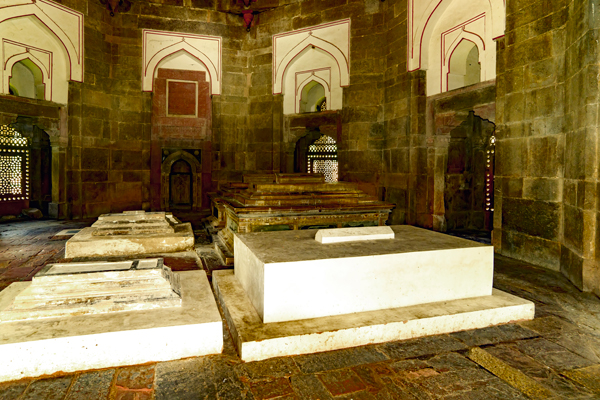THE EMPEROR
Nasr Ud Din Muhamaed Humayun the second Mughal emperor of India was just different. Born in Kabul to Mahim Begum and Babur in 1508 his name Humayun meant “the fortunate” in Persian. Ironically, misfortune dogged him all his life! Babur had managed only to partially subdue the Rajputs and the Pathans under Ibrahim Lodi when he died, leaving the 23-year-old Humayun with the idea of an empire but not an established one.
Humayun had different interests from the kings and Sultans of the day. While they excelled in statecraft and strategies of war, he was a scholar, well read in three languages and far more interested in Mathematics, Philosophy, Astronomy and Astrology than in battles. It is no surprise therefore that lacking his father’s skills in diplomacy and warfare, he was soundly defeated twice in battles by the resurgent Pathans united under the warlord Sher Khan who was later called Sher Shah. There is a story, perhaps apocryphal, that he fled after his defeat in the battle of Chausa by crossing the river Ganges with the aid of a large inflated leather bag used to carry water!
Only after the death of Sher Shah with the Pathans in disarray and with the aid of Iranian troops, he was able to gradually win back Delhi. Humayun’s good fortune deserted him again in just a year. Hurrying down the steep steps of his library to answer the Muezzin’s call to prayers while carrying a handful of books, he stumbled and fell, breaking his skull and dying soon afterwards. The year has 1556 and Humayun were only 47 years old. Although not as accomplished as his father before him or his son Akbar the Great after him, Humayun has the distinction of being buried in the grandest Muslim tomb in Delhi with the exception of the Taj Mahal and perhaps, Akbar’s tomb at Sikandra.
THE WET NURSE
It was customary for royal Mughal children to have wet nurses. Along with the royal mothers in the harem, they too enjoyed a position of high esteem. Humayun’s wet nurse, Bu Halima was no exception. Not much is known about this Mughal lady in Babur’s harem except that she was nobility. Humayun held her in such high affection and esteem that he had her tomb built in a garden scarcely 100 yards away from his own tomb. The surrounding garden and the entrance gate bear Bu Halima’s name to this day. Her tomb is remarkable since it has a flat roof and no dome. Strangely, her grave is left open to the sky leading some to speculate that the work was never finished!
THE ENEMY
Curiously, while building his tomb, Humayun did not demolish the 20-year-old tomb of Isa Khan Niazi a Pashtun nobleman of Sher Shah’s court and a sworn enemy from his past, though it was close by. Was Humayun thinking of the wise strategy of the Chinese General Sun Tzu who said “Keep your friends close but your enemies closer” or was he moved by a tolerance of a rare kind to leave his enemy’s tomb undisturbed? History provides no answer.

Isa Khan Niazi was in the service of Sher Shah Suri, the bane of Humayun’s life. Sher Shah drove Humayun out to take the throne of Delhi. He then declared himself Sultan of India and rewarded his most trusted lieutenant Isa Khan with the title Azm-e-Humayoon and gave him the governorship of Multan. Isa Khan decided to build himself a tomb which was constructed within his lifetime, during 1547 – 48. He died a few months later and was laid to rest in his magnificent octagonal tomb.
Isa Khan’s tomb is octagonal, located at the centre of a sunken garden. The tomb is a fine example of the architectural style that belongs to the Lodi period. The lady Willington Park or the modern Lodi Gardens in central Delhi has many similar octagonal tombs including those of Muhammed Shah and Sikander Lodi.
Isa Khan’s Tomb is built mainly of local grey quartzite tastefully ornamented with red sandstone. The rough masonry is covered with stucco plaster, and glazed tiles of different colours have been used to decorate the walls.

The tomb stands on a podium up a flight of five steps. The main gate has a square-¬headed doorway surprisingly, of Hindu design. All eight sides of the tomb chamber are open except the South and the West ones which are closed with stone fretwork or Jalis. Inside the tomb there are two large graves and four smaller ones. The grave of Isa Khan, one of the two larger, is of marble and red sandstone. The floor is paved with sandstone slabs.

Isa Khan’s Mosque, stands immediately to the west of his tomb, inside the same enclosure. It is a simple structure with a central large dome and two smaller side domes supported on pillars. The interior of the mosque is simple with hardly any decoration. The floor of the chamber is plastered, not paved like the tomb.
UNINTENDED IRONY
There you have it then, the tale of the Emperor whose name signified “the fortunate” being dogged by misfortune all his life, his wet nurse Bu Halima, so beloved of him that he made sure she was buried close by as if to ensure that he could get sustenance from her even in the afterlife! Close by lay the mortal remains of his great enemy who was tauntingly given the title of Azm-e-Humayoon! One wonder what their ghosts would say to one another were they to meet in the darkness of a moonless, stormy night? Would they speak of the past glories of the Pathan and Mughal empires of Hindoosthan, or would they look around despairingly and exclaim like Puck in A Midsummer Night’s Dream, “Lord, what fools these mortals be”?
–
Jayant Neogy – I am a slow learner. So, it takes me time as I plod along!
As usual, the author/photographer delivers a pleasant lesson in aesthetics, history, philosophy and humor.